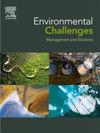Metagenomic insights into pathogenic bacteria and antimicrobial resistance in offshore coastal sediments – An example from Gulf waters
Q2 Environmental Science
引用次数: 0
Abstract
The environment-mediated spread of antimicrobial resistance (AMR) has become a serious public health issue. Globally, indiscriminate waste discharges in marine environments are one of the key contributors to pathogenic bacteria, antibiotic resistance genes (ARGs), and mobile genetic elements (MGEs). In this communication, we report the presence of 192 known bacterial pathogens at sites 3–40 km away from the coast of Kuwait. Pseudomonas aeruginosa was the most dominant species, recording a relative abundance of 88 % even at remote sites. Other pathogens, such as Enterococcus faecium, Staphylococcus aureus, Klebsiella pneumonia, Acinetobacter baumannii, Enterobacter cloacae, and Escherichia coli, prioritised by the World Health Organization (WHO) were also recorded. The raw sequencing reads matched with 667 ARGs, 1606 plasmids, 167 integrons and 2143 insertion sequences. The ARGs exhibited spatial variations and were distributed into three overlapping clusters (r2 = 0.277; p < 0.006). The observed Shannon and Simpson indices differed between the groups (ANOVA-p < 0.05). A positive correlation (R2–0.175, p < 0.065) between faecal sterols and ARGs was recorded. The presence of ARGs in non-polluted sites likely suggests that they are not restricted to waste outlets; it is quite probable that other emerging contaminants are also leading to AMR occurrence in the region. Hence, comprehensive screening and constant surveillance are warranted.

近海沉积物中致病菌和抗菌素耐药性的宏基因组研究——以海湾水域为例
环境介导的抗菌素耐药性(AMR)传播已成为一个严重的公共卫生问题。在全球范围内,海洋环境中不加区分的废物排放是致病菌、抗生素耐药基因(ARGs)和移动遗传元件(MGEs)的主要因素之一。在本通讯中,我们报告在距离科威特海岸3-40公里的地点发现了192种已知的细菌病原体。铜绿假单胞菌是最主要的菌种,即使在偏远地区也记录了88%的相对丰度。其他病原体,如屎肠球菌、金黄色葡萄球菌、肺炎克雷伯菌、鲍曼不动杆菌、阴沟肠杆菌和大肠杆菌,也被世界卫生组织(WHO)列为重点。原始测序结果与667个ARGs、1606个质粒、167个整合子和2143个插入序列相匹配。ARGs具有明显的空间差异,分布在3个重叠的集群中(r2 = 0.277;p & lt;0.006)。观察到的Shannon和Simpson指数在两组之间存在差异(方差分析-p <;0.05)。正相关(R2-0.175, p <;0.065)。在未受污染的地点出现ARGs,可能表明它们并不局限于废物出口;很有可能其他新出现的污染物也导致了该地区抗菌素耐药性的发生。因此,全面筛查和持续监测是必要的。
本文章由计算机程序翻译,如有差异,请以英文原文为准。
求助全文
约1分钟内获得全文
求助全文
来源期刊

Environmental Challenges
Environmental Science-Environmental Engineering
CiteScore
8.00
自引率
0.00%
发文量
249
审稿时长
8 weeks
 求助内容:
求助内容: 应助结果提醒方式:
应助结果提醒方式:


